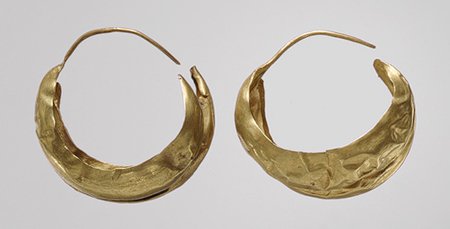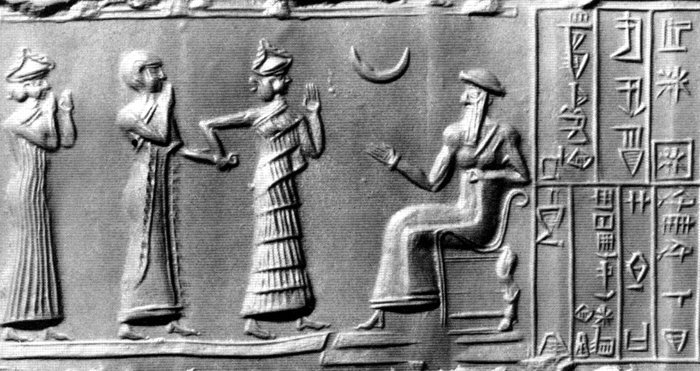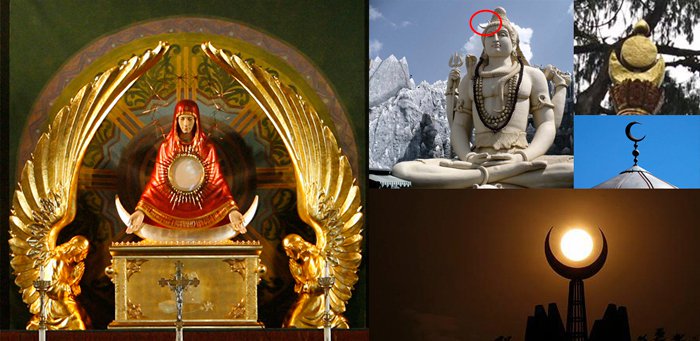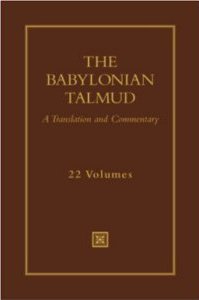Problems with Using the First Visible Crescent
- Using the first visible crescent method, it is impossible for the world to consistently begin the Feasts during the same 24-hour period.
- Not consistent with the principles governing the Biblical parameters of a day
- Chodesh, the Hebrew word for "New Moon," is used in Scripture more than 270 times, yet it is not used even once to denote seeing something (i.e. the visible moon, the crescent, ...). The Hebrew word for "crescent," śaharōnîm, is used exclusively in connection to idolatry.
- Not in harmony with Psalm 81:3
- Not in harmony with Genesis 1
- Not in harmony with Nature's (Creation's) testimony
- Not in harmony with the Writings of Philo, a contemporary of our Saviour (20 B.C.–50 A.D.)
(Refer to Lesson #2, The Biblical Argument, for an expanded explanation of the points above.)
Additional Information to Consider
Ties to Babylon
“The [Babylonian]months began at the first visibility of the New Moon, and in the 8th century B.C.E. court astronomers still reported this important observation to the Assyrian kings. . . . The Babylonian month names were Nisanu, Ayaru, Simanu, Du'uzu, Abu, Ululu, Tashritu, Arakhsamna, Kislimu, Tebetu, Shabatu, Adaru. The month Adaru II was intercalated six times within the 19-year cycle but never in the year that was 17th of the cycle, when Ululu II was inserted. Thus, the Babylonian calendar until the end preserved a vestige of the original bipartition of the natural year into two seasons, just as the Babylonian months to the end remained truly lunar and began when the New Moon was first visible in the evening. The day began at sunset." (http://www.webexhibits.org/calendars/calendar-ancient.html)
It must be acknowledged that just because it was a custom in Babylon does not mean that it is wrong. However, it is certainly worth noting that the Babylonian custom of reckoning a new month revolved around sighting the first visible crescent. It is not unlikely at all that the Jews, sometime after the first century, adopted this method in place of the Biblical reckoning, just as they adopted the unBiblical Babylonian practice of beginning the day at sundown as well as the Babylonian names of the months.
The below passages clearly condemn crescent veneration, which was evidently a custom among the heathen nations. To be fair, this does not by default disqualify the first visible crescent methodology for reckoning New Moon Day, but it must be taken into consideration when honestly weighing the evidence.
Then Zeḇaḥ and Tsalmunna said, “Rise yourself, and fall on us. For as a man is, so is his might.” So Giḏʽon arose and slew Zeḇaḥ and Tsalmunna, and took the crescent ornaments which were on their camels’ necks. So the men of Yisra’ĕl said to Giḏʽon, “Rule over us, both you and your son, also your son’s son, for you have saved us from the hand of Miḏyan.” But Giḏʽon said to them, “I do not rule over you, nor does my son rule over you. יהוה does rule over you.” And Giḏʽon said to them, “I have a request to make of you, that each of you give me the ring from his spoil.” For they had rings of gold, because they were Yishmaʽĕlites. And they said, “We shall certainly give them.” And they spread out a garment, and each man threw into it the ring from his spoil. And the weight of the gold rings that he requested was one thousand seven hundred pieces of gold – besides the crescent ornaments, and the pendants, and purple robes which were on the sovereigns of Miḏyan, and besides the chains that were around their camels’ necks. (Judges 8:21-26, ISR)
 |
|
Lunate earrings, 2500–2400 B.C.; |
"Archaeological evidence reveals the common use of ornaments in the shape of the sun disk or inverted moon crescent, a symbol of the goddess Ishtar-Astarte, worn by women or animals to increase their fertility (Jdg. 8:21)." (New Bible Dictionary, Article "Amulets," p.34)
In that day יהוה takes away the finery of the anklets, and the headbands, and the crescents, the pendants, the bracelets and the veils, the headdresses, and the leg ornaments, and the sashes, and the perfume bottles, and the amulets, the rings, and the nose jewels, the costly robes, and the cloaks, and the shawls, and the purses, the mirrors, and the fine linen, and the turbans, and the large veils. (Isaiah 3:18-23, ISR)
The Hebrew word (H7720 - śaharōnîm), here translated as "crescent," is found only three times in Scripture and is used only in connection to heathen idolatry (Judges 8:21 & 26; Isaiah 3:18). This word is never associated with the "New Moon" or even the "month." Not one of the inspired authors of Scripture used śaharōnîm when writing about the appointed feasts or the month.
"The Crescent was a favorite amulet among many peoples of Western Asia, and it represented to them the strength and protection of the waxing and not the waning moon." (Amulets and Superstitions, E. A. Wallis Budge, p.213)
"Before Jacob went to Bethel to present himself before Yahweh he made all his people to hand over to him their 'strange gods' and ear-rings (i.e. crescent-shaped amulets), and he hid them under the oak which was in Shechem [Genesis 35:4]." (Ibid, p. 214)
It is worth noting that Sin, one of Babylon's chief gods, is represented by a crescent.
"On cylinder seals, he [Sin] is represented as an old man with a flowing beard and the crescent symbol. . . . The cult of the moon-god spread to other centers, so that temples to him are found in all the large cities of Babylonia and Assyria." (http://en.wikipedia.org/wiki/Sin_(mythology))

Sin worship was also prevalent in Arabia in the days of Muhammad. Consequently, Islam venerates the crescent to this day. Many religions with Babylonian roots venerate the crescent (i.e. Roman Catholicism, Hinduism, Buddhism, etc.).

The idolatrous practices of the heathen religions, rooted in Babylon, stand in austere opposition to Yahuwah's admonitions for His people.
And take heed, lest you lift your eyes to heaven, and when you see the sun, the moon, and the stars, all the host of heaven, you feel driven to worship them and serve them, which Yahuwah your Eloah, has given to all the peoples under the whole heaven as a heritage. (See Deuteronomy 4:19.)
About 600 years before the birth of our Saviour, Yahuwah reprimanded the inhabitants of Judah through the prophet Jeremiah for their idolatrous behavior, which included making crescent shaped cakes as an offering to the "queen of heaven." Sadly, the men of Judah did not heed Jeremiah's warning, as they believed that their idolatrous practices were the source of their prosperity.
"But since we left off to burn incense to the queen of heaven, and to pour out drink offerings unto her, we have wanted all things, and have been consumed by the sword and by the famine. And when we burned incense to the queen of heaven, and poured out drink offerings unto her, did we make her cakes to worship her, and pour out drink offerings unto her, without our men?" (Jeremiah 44:18-19, KJV)
"To worship her - Rather, to represent her image. The cakes were made in the shape of a crescent to represent the moon." (Barnes Commentary)
"Crescent-shaped cakes were offered to the moon." (Jamieson-Fausset-Brown Commentary)
Throughout Scripture, crescent veneration is mentioned exclusively in relation to idolatry and Israel's adoption of heathen practices.
First Visible Crescent: Examining the Alleged Historical Evidence
One thing is certain; the method being used to reckon New Moon Day in Yahushua's day was the correct one. There is no indication in the New Testament that there was ever a dispute as to when the Sabbaths and Feast Days occurred. Clearly, the method then being used was correct, as it was endorsed by Yahushua.
Many sincere lunar Sabbatarians often cite Jewish oral tradition (i.e. the Babylonian Talmud) as evidence that the first visible crescent was being used in Yahushua's day to reckon New Moon Day. But is the Talmud reliable? Can we, with Heaven's blessing, sweep all contrary evidence aside in favor of building primarily on the oral traditions of the those who trace their roots to the Pharisees?
 The Talmud essentially consists of two parts: (1) Mishna: First major publication of the Jewish oral traditions, 220 AD; (2) Gemara: Rabbinical analysis of and commentary on the Mishnah, c. 500 AD. In the Mishnah, we find many rules, regulations, and references pertaining to the rabbinical court's role in examining witness to ascertain if the new moon had been sighted. For example:
The Talmud essentially consists of two parts: (1) Mishna: First major publication of the Jewish oral traditions, 220 AD; (2) Gemara: Rabbinical analysis of and commentary on the Mishnah, c. 500 AD. In the Mishnah, we find many rules, regulations, and references pertaining to the rabbinical court's role in examining witness to ascertain if the new moon had been sighted. For example:
"The following are considered incompetent to be witnesses: gamblers with dice, usurers, pigeon breeders, those who deal with the produce of the sabbatic year, and slaves. This is the rule: All evidence that cannot be received from a woman cannot be received from any of the above. . . . Whenever (witnesses) must be on the road a day and a night, it will be lawful to violate the Sabbath to travel thereon, to give their evidence as to the appearance of the moon." (Babylonian Talmud, Section Moed, Rosh Hashana, Chapter I, http://www.jewishvirtuallibrary.org/jsource/Talmud/rh1.html)
Note: The above quotation actually makes no sense in the context of the Biblical luni-solar calendar. The earliest the moon could be sighted using the first visible crescent method would be following the sunset of the last Sabbath (the 29th). It makes no sense, then, to make allowances for someone to travel on the Sabbath to testify that they had sighted the moon before a moon sighting would even be possible. The Talmud, though, does not vindicate the Biblical calendar. Rather, it promotes Babylonian calendar principles (e.g. sunset to sunset days) and pagan calendation (e.g. Saturday Sabbath).
"There was a large court in Jerusalem called Beth Ya'azeq, where all the witnesses met, and where they were examined by the Beth Din. Great feasts were made there for (the witnesses) in order to induce them to come frequently. . . . How were the witnesses examined? The first pair were examined first. The elder was introduced first, and they said to him: Tell us in what form thou sawest the moon; was it before or behind the sun? Was it to the north or the south (of the sun)? What was its elevation on the horizon? Towards which side was its inclination? What was the width of its disk? If he answered before the sun, his evidence was worthless. After this they introduced the younger (witness) and he was examined; if their testimony was found to agree, it was accepted as valid; the remaining pairs (of witnesses) were asked leading questions, not because their testimony was necessary, but only to prevent them departing, disappointed . . . " (Babylonian Talmud, Section Moed, Rosh Hashana, Chapter II, http://www.jewishvirtuallibrary.org/jsource/Talmud/rh2.html )
"R. Gamaliel had on a tablet, and on a wall of his upper room, illustrations of the various phases of the moon, which he used to show to the common people, saying: 'Did you see the moon like this figure or like this?'" (Ibid.)
The Talmud, though, vindicates many unBiblical doctrines. For example:
Four beginnings to the year - "There are four New Year days, viz.: The first of Nissan is New Year for (the ascension of) Kings and for (the regular rotation of) festivals; the first of Elul is New Year for the cattle-tithe, but according to R. Eliezer and R. Simeon, it is on the first of Tishri. The first of Tishri is New Year's day, for ordinary years, and for sabbatic years and jubilees; and also for the planting of trees and for herbs. On the first day of Shebhat is the New Year for trees, according to the school of Shammai; but the school of Hillel says it is on the fifteenth of the same month." [Note: The Babylonian names of the months.] (http://www.jewishvirtuallibrary.org/jsource/Talmud/rh1.html)
Saturday Sabbath (with a sunset to sunset reckoning) - "The rabbis taught: One shall not send a letter by a Gentile on Friday unless he stipulated a certain sum for the delivery. If such a stipulation was not made, the Beth Shamai says it must not be delivered, unless the messenger has time to reach the house in which it is to be delivered (before sunset); the Beth Hillel, however, maintains: He may do it if the messenger has time to reach the house nearest to the wall of the city where the letter is to be delivered." (Babylonian Talmud, Section Moed, Shabbat, Chapter II, http://www.jewishvirtuallibrary.org/jsource/Talmud/shabbat1.html)
Was a Saturday Sabbath (Friday evening to Saturday evening) being observed by Yahuwah's faithful during Yahushua's earthly ministry? No, absolutely not. Scripture is clear that Yahuwah's calendar is luni-solar, and a Biblical day begins at dawn, not sunset The unBiblical Saturday Sabbath was clearly adopted by the authors of the Talmud after the first century, as was the Babylonian practice of beginning the day at sunset. This point cannot be overemphasized. We know with certainty that these unBiblical practices were adopted after the time of Yahushua, yet there they are, side by side with the same authors' testimony that the New Moon was reckoned by the first visible crescent. It does not seem reasonable or responsible to suggest that we should embrace the first visible crescent methodology (and alleged history) espoused by the authors of the Talmud, when we have full knowledge that the same group of individuals penned doctrines that are antithetical to the plain teachings of Scripture. Clearly, the Talmud is not a trustworthy reflection of the Jewish economy during the earthly ministry of Yahushua.
|
The Babylonian Talmud, according to the rabbis who penned it, is more deserving of obedience than the Bible! "It is written [Ecclesiastes xii. 12]: . . . This means: 'My son, be careful in the observance of the rabbinical commandments (even more than in the biblical); for while the biblical commandments are for the most part positive and negative . . . the rabbinical commandments, if infracted, would involve capital punishment." (The Babylonian Talmud, Section Moed, Erubin 21b, Chapter II, http://www.jewishvirtuallibrary.org/jsource/Talmud/eruvin2.html) |
Also included in the Talmud is an incredibly vast list of almost every act imaginable that is either allowed or forbidden on the Sabbath - according to the rabbis. The Talmud is essentially a compilation of the exactions and traditions set forth by the Pharisees. How much weight can we give a book whose foundation is established on nothing more than the oral traditions of those who rejected the Lamb of Yahuwah and shunned the Light of the world?
"Then came to Yahushua scribes and Pharisees, which were of Jerusalem, saying, Why do thy disciples transgress the tradition of the elders? for they wash not their hands when they eat bread. But he answered and said unto them, Why do ye also transgress the commandment of Elohim by your tradition?" (Matthew 15:1-3, RNKJV)
We must never give more weight to tradition than is due. While all available information must be taken into consideration when conducting an honest investigation, we must always consider the source and pledge our allegiance to the weight of evidence, even if the conclusion does not agree with our presupposition.
While many historians, encyclopedias, and Bible dictionaries testify that the Biblical month began with the first visible crescent, none offer any real evidence to support their claims. It seems likely that they are relying largely on tradition, as the authors of the Universal Jewish Encyclopedia readily admit.
"Little is known of the procedure of determining the calendar up to the 2nd cent. C.E., when a description is given of the traditional practice, it ran as follows: On the thirtieth day of the month a council would meet to receive the testimony of witnesses that they had seen the new moon. If two trustworthy witnesses had made deposition to that effect on that day, the council proclaimed a new month to begin on that day… If no witnesses appeared, however, the new moon was considered as beginning on the day following the thirtieth." (Universal Jewish Encyclopedia, p.632)
The point, here, is simply this. We cannot, as responsible Bible students, build exclusively upon the oral traditions of the Jews, while sweeping all other evidence under the proverbial rug. We must prayerfully commit ourselves always to the weight of evidence, wherever it may lead.








